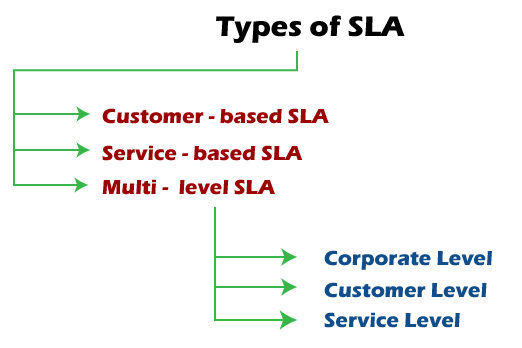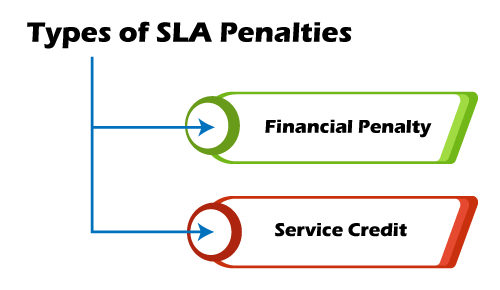A service-level agreement (SLA) is a commitment between a service provider and a client. Particular aspects of the service, such as quality, availability, responsibilities are agreed upon between the service provider and the service user. It defines:
- The metrics used to measure the level of service provided.
- Remedies or penalties resulting from failure to meet the promised service level expectations.
The most common component of an SLA is that the services should be provided to the customer as agreed upon in the contract. It is a critical component of any technology vendor contract. For example, Internet service providers will commonly include service level agreements within the terms of their contracts with customers to define the level of service being sold in plain language terms. Usually, SLAs are between companies and external suppliers, but they may also be between two departments within a company.
In this case, the SLA will typically have a technical definition in mean time between failures (MTBF), mean time to repair or mean time to recovery (MTTR), identifying which party is responsible for reporting faults or paying fees, responsibility for various data rates, throughput, jitter, or similar measurable details. The Service Level Agreement includes:
- Detailed service overview
- Speed of service delivery
- Plan for performance monitoring
- Description of the reporting procedure
- List of penalties that will be applied in case of agreement violations
- Constraints
Types of SLA
The selection of the types of SLA in an organization depends on many significant aspects.

While some are targeted at individual customer groups, others discuss issues relevant to entire companies. This is because the needs of one user differ from another. Here are some types of SLAs used by businesses today and how each one is utilized for specific situations:
1. Customer-based SLA
This type of agreement is used for individual customers and comprises all relevant services that a client may need while leveraging only one contract. It contains details regarding the type and quality of service that has been agreed upon.
For example, a telecommunication service includes voice calls, messaging, and internet services, but all exist under a single contract.
2. Service-based SLA
This SLA is a contract that includes one identical type of service for all of its customers. Because the service is limited to one unchanging standard, it is more straightforward and convenient for vendors.
For example, using a service-based agreement regarding an IT helpdesk would mean that the same service is valid for all end-users that sign the service-based SLA.
3. Multi-level SLA
This agreement is customized according to the needs of the end-user company. It allows the user to integrate several conditions into the same system to create a more convenient service. This type of SLA can be divided into the following subcategories:
- Corporate level: This SLA does not require frequent updates since its issues are typically unchanging. It includes a comprehensive discussion of all the relevant aspects of the agreement and applies to all customers in the end-user organization.
- Customer level: This contract discusses all service issuesthat are associated with a specific group of customers. However, it does not take into consideration the type of user services.
For example, when an organization requests that the security level in one of its departments is strengthened. In this situation, the entire company is secured by one security agency but requires that one of its customers is more secure for specific reasons. - Service level: In this agreement, all aspects attributed to a particular service regarding a customer group are included.
Components of SLA
An SLA highlights what the client and the service provider want to achieve with their cooperation and outlines the obligations of the participants, the expected performance level, and the results of cooperation.
An SLA usually has a defined duration time that is provided in the document. The services that the provider agrees to deliver are often described in detail to avoid misunderstanding, including procedures of performance monitoring, assessment, and troubleshooting. Here are the following components necessary for a good agreement:
- Document overview: This first section sets forth the basics of the agreement, including the parties involved, the start date, and a general introduction of the services provided.
- Strategic goals: Description of the agreed purpose and objectives.
- Description of services: The SLA needs detailed descriptions of every service offered under all possible circumstances, including the turnaround times. Service definitions should include how the services are delivered, whether maintenance service is offered, what the hours of operation are, where dependencies exist, an outline of the processes, and a list of all technology and applications used.
- Exclusions:Specific services that are not offered should also be clearly defined to avoid confusion and eliminate room for assumptions from other parties.
- Service performance: Performance measurement metrics and performance levels are defined. The client and service provider should agree on a list of all the metrics they will use to measure the provider's service levels.
- Redressing: Compensation or payment should be defined if a provider cannot properly fulfill their SLA.
- Stakeholders:Clearly defines the parties involved in the agreement and establishes their responsibilities.
- Security: All security measures that the service provider will take are defined. Typically, this includes the drafting and consensus on antipoaching, IT security, and nondisclosure agreements.
- Risk management and disaster recovery:Risk management processes and a disaster recovery plan are established and communicated.
- Service tracking and reporting: This section defines the reporting structure, tracking intervals, and stakeholdersinvolved in the agreement.
- Periodic review and change processes. The SLA and all established key performance indicators (KPIs) should be regularly reviewed. This process is defined as well as the appropriate process for making changes.
- Termination process. The SLA should define the circumstances under which the agreement can be terminated or will expire. The notice period from either side should also be established.
- Finally, all stakeholders and authorized participants from both parties must sign the document to approve every detail and process.
Common Metrics of SLA
Service-level agreements can contain numerous service-performance metrics with corresponding service-level objectives. A common case in IT-service management is a call center or service desk. Metrics commonly agreed to in these cases include:
- Abandonment Rate: Percentage of calls abandoned while waiting to be answered.
- ASA(Average Speed to Answer): Average time (usually in seconds) it takes for a call to be answered by the service desk.
- Resolution time:The time it takes for an issue to be resolved once logged by the service provider.
- Error rate:The percentage of errors in a service, such as coding errors and missed deadlines.
- TSF(Time Service Factor): Percentage of calls answered within a definite timeframe, e.g., 80% in 20 seconds.
- FCR(First-Call Resolution): A metric that measures a contact center's ability for its agents to resolve a customer's inquiry or problem on the first call or contact.
- TAT(Turn-Around-Time): Time is taken to complete a particular task.
- TRT(Total Resolution Time): Total time is taken to complete a particular task.
- MTTR(Mean Time To Recover): Time is taken to recover after an outage of service.
- Security:The number of undisclosed vulnerabilities, for example. If an incident occurs, service providers should demonstrate that they've taken preventive measures.
Uptime is also a common metric used for data services such as shared hosting, virtual private servers, and dedicated servers. Standard agreements include the percentage of network uptime, power uptime, number of scheduled maintenance windows, etc. Many SLAs track to the ITIL specifications when applied to IT services.
Types of SLA Penalties
A natural reply to any violation is a penalty. An SLA penalty depends on the industry and business. Here are the two most common SLA penalty types.

1. Financial penalty
This kind of penalty requires a vendor to pay the customer compensation of damages equal to the one written in the agreement. The amount will depend on the extent of a violation and damage and may not fully reimburse what a customer paid for the eCommerce service or eCommerce support.
- License extension or support:It requires the vendor to extend the license term or offer additional customer support without charge. This could include development and maintenance.
2. Service credit
In this case, a service provider will have to provide a customer with complimentary services for a specific time. To avoid any confusion or misunderstanding between the two parties in SLA violation, such penalties must be clearly articulated in the agreement. Otherwise, they won't be legitimate.
- Service availability:It includes factors such as network uptime, data center resources, and database availability. Penalties should be added as deterrents against service downtime, which could negatively affect the business.
- Service quality:It involves performance guarantee, the number of errors allowed in a product or service, process gaps, and other issues that relate to quality.
These penalties must be specified in the language of the SLA, or they won't be enforceable. In addition, some customers may not think the service credit or license extension penalties are adequate compensation. They may question the value of continuing to receive a vendor's services that cannot meet its quality levels.
Consequently, it may be worth considering a combination of penalties and including an incentive, such as a monetary bonus, for more than satisfactory work.
Revising and Changing an SLA
Since business requirements are subject to change, it's important to revise an SLA regularly. It will help to always keep the agreement in line with the business's service level objectives. The SLA should be revised when changes of the following occur:
- A company's requirements
- Workload volume
- Customer's needs
- Processes and tools
The contract should have a detailed plan for its modification, including change frequency, change procedures, and changelog.
1. SLA Calculation
SLA assessment and calculation determine a level of compliance with the agreement. There are many tools for SLA calculation available on the internet.
2. SLA uptime
Uptime is the amount of time the service is available. Depending on the type of service, a vendor should provide minimum uptime relevant to the average customer's demand. Usually, a high uptime is critical for websites, online services, or web-based providers as their business relies on its accessibility.
3. Incident and SLA violations
This calculation helps determine the extent of an SLA breach and the penalty level foreseen by the contract. The tools usually calculate a downtime period during which service wasn't available, compare it to SLA terms and identify the extent of the violation.
4. SLA credit
If a service provider fails to meet the customer's expectations outlined in the SLA, a service credit or other type of penalty must be given as a form of compensation. A percentage of credit depends directly on the downtime period, which exceeded its norm indicated in a contract.
Service Level Management
Service level management is the process of managing SLAs that helps companies to define, document, monitor, measure, report, and review the performance of the provided services. The professional SLA management services should include:
- Setting realistic conditions that a service provider can ensure.
- Meeting the needs and requirements of the clients.
- Establishing the right metrics for evaluating the performance of the services.
- Ensuring compliance with the terms and conditions agreed with the clients.
- Avoiding any violations ofSLA terms and conditions.
An SLA is a preventive means to establish a transparent relationship between both parties involved and build relationships in the cooperation. Such a document is fundamental to a successful collaboration between a client and a service provider.

No comments:
Post a Comment